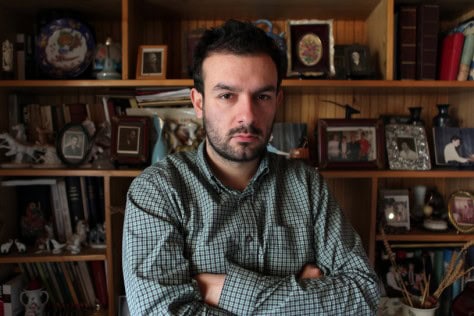Charles Burns is best known in the comic world for his contributions to RAW, a comics magazine founded by Art Spiegelman, and 400-page magnum opus, Black Hole (Pantheon), and while you may not have read or seen any of his comic work, you've doubtless glimpsed the countless commercial works he's done for The Believer magazine, the New Yorker, Altoids, and a handful of novels and short story collections.
Now with a film adaptation of Black Hole, directed by David Fincher, on the horizon and another, Peur(s) du noir (Fear(s) of the Dark), in the can, Burns is breaking into an entirely new industry. Anthem sat down with the multi-disciplinary artist while he was in Los Angeles.
How did you come up with the idea for Black Hole?
It was an idea that was floating around. I think it started more as something in a sketchbook, a visual idea, where I was taking these kinds of teenage characters and messing around with them―putting some diseases, skin ailments, playing with them. Then I started thinking about this whole idea, wanting to do a story about adolescence, thinking of adolescence as this disease that some people get over, some people don’t get over. So I did a few false starts, not false starts—a few earlier stories where I kind of worked through this idea, or played around with it. There was a Big Baby story, where his babysitter’s boyfriend has this rash that’s kind of growing under his clothes, and kind of slowly moving up towards his face. There was a short thing for Raw Magazine. But anyway, it was a kind of theme that I wanted to delve into for a much longer story
You spent a decade working on Black Hole. Why did you spend so long on one particular story?
There were a number of reasons for that. I work slowly. My straight job is doing illustration and advertising. Starting and stopping when I had time to work on it, with the intention of getting at least an issue out each year. It was a slow process. That being said, it was always looked at as being this whole piece, this collection. It was designed that way, almost like a jigsaw puzzle or a mosaic, where all the pieces are eventually going to come together. All the fragments, all the plot threads are going to come together.
Up until then almost all of your work had been a lot shorter, right?
Oh yeah, my work had been much shorter and when I started Black Hole I had this idea that I really wanted to do a story about the characters, a much more character-driven story. Not so much about the intricacies of the plot, but more about really getting into the characters. Finding my way into the characters and having a much more personal story in that I was putting more of myself into the characters and delving into that.
Unlike many independent comics creators, you have not worked on anything that could be considered a memoir. Any particular reason for this?
I’ve never really wanted to do a memoir per se. Black Hole is definitely based on elements of friends of mine, situations I was in, things I was going through and things I was thinking about. So in that regard it has those certain moments that are pulled straight out of my life or at least the feelings I was going through at that time. I don’t think I’ve got the kind of temperament to write that; it’s not something that intrigues me, to delve into that memoir sort of thing. There are people who do it really well, but it’s not something that I’m interested in or drawn towards.
Overall, what are your feelings on Black Hole?
Well I guess thinking about it in terms of a decade worth of work, it’s a little disturbing to think that here’s this portion of your life that you devoted to this work. But that’s just the nature of the way I work and the nature of comics themselves. They’re labor intensive and they take a while to work through. But in the end I’m happy with the book. There are no parts of it where I’m thinking, “Oh god, if I could go back and change this or that.” I think maybe because it took so long and I really labored over it and turned it inside out, I knew that I was happy with the final results. It came as close as I think I’ll get to the story I was after.
It seems as if a lot of people are exposed to your work through mediums other than comics. What do you think about this?
It’s all over the place. I mean there are people who’ve seen my comics and never seen my stuff in the New Yorker. I do the cover for The Believer each month, and I’m sure there are readers who have only seen that and don’t pay attention to the other stuff. There’s people who hire me for illustration and don’t know I do comics.
You started working on comics in the early 80s. Where did you get started?
I originally appeared in Raw Magazine, a comic anthology that Art Spiegelman and Francoise Mouly started in New York. I was living up in Philadelphia, met them, and started working.
How did you get involved in that?
It was just a matter of going up to New York and trying to show my portfolio. It was a matter of meeting them and being interested in the kind of work they were putting out in the magazine. Raw kind of started out as this more nontraditional, less narrative sort of comics. As they progressed, the content became more traditionally narrative stories.
Do you feel that working at Raw helped you?
In a way, it was my first exposure to meeting other cartoonists.
I assume making comics is normally a very solitary thing?
Of course.
Besides artists you met through Raw, who or what else has influenced you?
I guess just things that I was growing up with when I was real young. I was born in 1955, so there were things I saw around our house really early on. My dad was interested in comics and there were some reprints of early Mad comics. And I saw Tintin when I was young too.
Can you tell me a little about the project you are currently working on?
It’s a hard thing to explain, much harder than a story about teenagers with a disease. The take off point is the influence of looking at Tintin growing up, a series I looked at before I could read. I just kind of internalized a lot of imagery and ideas. The story, it’s kind of, I don’t know, two parallel story threads. One is a darker Tintin world and the other’s a more normal one set in the late 70s punk era. I’m playing off these two ideas.
Is this going to be another long piece of work?
No. I don’t have anything as long as Black Hole left in me. I think. No, it doesn’t feel like that. It’ll probably be at most 100 pages or so. It’ll be my first color comic, so it’s interesting to me to think about that element of color as a storytelling device.
I can imagine that after Black Hole, which is 400 pages of black and white art, this has to be kind of liberating?
Well it’s different. That story really demanded that style and that look. It’s perfectly suited for the story. In this case I don’t feel like repeating myself.
I actually started the story I’m working on now as this kind of black and white story and it just didn’t work. I found that I was repeating myself, it felt like a watered down version of the style in Black Hole. I just need to kind of try something new. It feels much more controlled. I actually give myself a little grid, a much more restricted grid to work on. It’s intentionally kind of mimicking that look of French/Belgium comic albums.
What is status of the Black Hole film project?
It was just announced that David Fincher is the director who’s attached—as they say—to the movie. I’m not involved in any of the creative process other than having this book that’s the focus of the story.
How do you feel about your work being adapted?
Recently I’ve been working on an animated movie that just came out in Paris, the English translation is called Fears of the Dark. It’s a feature with six different artists that are writing and directing a segment of a black and white animated movie about fears of the dark. But you were asking about the Black Hole film. I guess I made a decision that I didn’t want to pursue trying to keep control. I wanted to move on to other things. That’s pretty much it.
You work in both illustration and comics; at this point is there one you prefer? At this point in your life have comics become more of a side project?
No, not really. It’s a balancing act really. They’re both my work, but obviously with the comics I have complete control. There’s no editorial influence whatsoever in any way at all. I’m writing the story, I’m drawing it, I’m inking it, I’m designing the book, I’m designing the whole package. It really is something that I maintain complete control over. With illustration, you’re reading a story and creating something for a magazine. It’s not something you’re doing for yourself. They’re just two different worlds.
 Q&A with Larry Gus
Q&A with Larry Gus We Own the Night: The Edison
We Own the Night: The Edison
No Comments